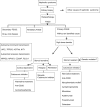Optimal management of primary focal segmental glomerulosclerosis in adults
- PMID: 28546764
- PMCID: PMC5436760
- DOI: 10.2147/IJNRD.S126844
Optimal management of primary focal segmental glomerulosclerosis in adults
Abstract
Focal segmental glomerulosclerosis (FSGS) is a frequent glomerular kidney disease that is revealed by proteinuria or even nephrotic syndrome. A diagnosis can be established from a kidney biopsy that shows focal and segmental glomerulosclerosis. This histopathological lesion may be caused by a primary podocyte injury (idiopathic FSGS) but is also associated with other pathologies (secondary FSGS). The first-line treatment for idiopathic FSGS with nephrotic syndrome is a prolonged course of corticosteroids. However, steroid resistance or steroid dependence is frequent, and despite intensified immunosuppressive treatment, FSGS can lead to end-stage renal failure. In addition, in some cases, FSGS can recur on a graft after kidney transplantation: an unidentified circulating factor may be implicated. Understanding of its physiopathology is unclear, and it remains an important challenge for the scientific community to identify a specific diagnostic biomarker and to develop specific therapeutics. This study reviews the treatment of primary FSGS and the recurrence of FSGS after kidney transplantation in adults.
Keywords: circulating factor; glomerulosclerosis; kidney transplantation; treatment.
Conflict of interest statement
Disclosure The authors report no conflicts of interest in this work.
Figures
References
-
- Haas M, Meehan SM, Karrison TG, Spargo BH. Changing etiologies of unexplained adult nephrotic syndrome: a comparison of renal biopsy findings from 1976-1979 and 1995-1997. Am J Kidney Dis. 1997;30(5):621–631. - PubMed
-
- D’Agati V. The many masks of focal segmental glomerulosclerosis. Kidney Int. 1994;46(4):1223–1241. - PubMed
-
- Haas M, Spargo BH, Coventry S. Increasing incidence of focal-segmental glomerulosclerosis among adult nephropathies: a 20-year renal biopsy study. Am J Kidney Dis. 1995;26(5):740–750. - PubMed
-
- Braden GL, Mulhern JG, O’Shea MH, Nash SV, Ucci AA, Jr, Germain MJ. Changing incidence of glomerular diseases in adults. Am J Kidney Dis. 2000;35(5):878–883. - PubMed
-
- Swaminathan S, Leung N, Lager DJ, et al. Changing incidence of glomerular disease in Olmsted County, Minnesota: a 30-year renal biopsy study. Clin J Am Soc Nephrol. 2006;1(3):483–487. - PubMed
Publication types
LinkOut - more resources
Full Text Sources
Other Literature Sources


